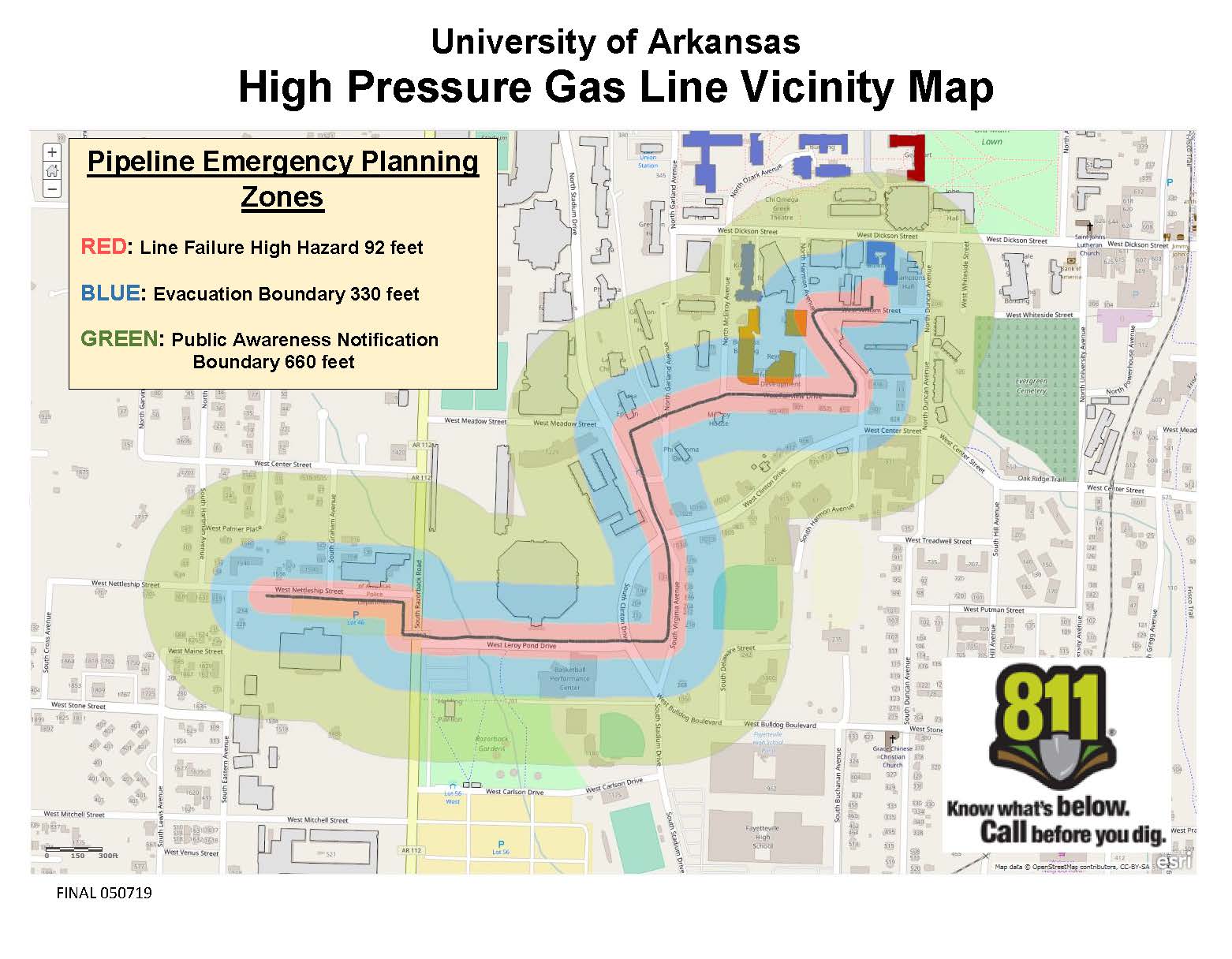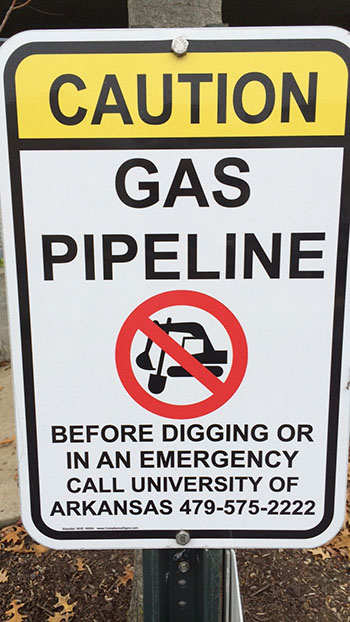Natural Gas Pipeline Safety
The University is committed to the health and safety of its students, faculty, staff and community who live in and around the campus. We acknowledge the same responsibility to parents, alumni, and the many other groups who choose to visit our growing campus.
The safe operation and ongoing protection of the University natural gas pipeline is important to senior leadership and a responsibility we take seriously. Natural gas is one of the safest and most useful fuels we have available today, but it requires our ongoing respect and continued vigilance to ensure that it continues to serve our needs in a safe and effective manner.
Leak Response
What to do if you think there is a Leak
Leave the Area!
- DO NOT try to find the leak.
- DO NOT use your Cell Phone
- DO NOT turn lights On or Off
- DO NOT create fire or try to cause any sparks when leaving.
Recognizing a Natural Gas Leak
Natural gas lines are usually very safe.
How do you sense the presence of natural gas?
- With your Nose: Natural gas normally has no smell – but a chemical is added that smells like rotten eggs, sulfur or even vinegar – so that if there is a leak everyone knows it is natural gas.
- With your Ears: A leak in a pressurized gas main will sound like a hissing noise that can range from air leaking out of a tire to a loud roar.
- With your Eyes: If there is a gas leak, there might be fire coming up out of the ground, dirt blowing in the air or chunks of pipe and debris lying around. A less obvious sign is a large section of dead vegetation, but it’s usually obvious there’s a problem by this point.
If you detect any of these things, leave the area, tell those around you to leave, and call 911 to report the leak.
Call before digging
Arkansas One Call – 811
Arkansas One Call is the statewide government agency in place to protect, prevent and react to pipeline issues. The 811 hotline is there to help prevent natural gas disasters by offering services and information on digging.
You should always call One Call a few days before you dig. Arkansas laws states that the call must be made at least two days before digging and markers set in place to indicate where is safe to dig are only valid for 20 days.
Hand Digging Around Buried Facilities
Call Utility Operations at 479-575-5300 at least two days before you dig. This is a free service that will allow pipeline workers to place markings on the ground indicating where you should and should not dig.
You should also call Arkansas One Call!
Under any circumstance, if you ever see a pipeline exposed while digging, contact the University at the number above. No matter if you think you did or did not do damage to the line, it is imperative that the line be inspected prior to being covered back up. Exposed pipelines are dangerous.
Request UA Natural Gas Pipeline Drawings
To request drawings of the University of Arkansas natural gas pipeline, please call Utility Operations at 479-575-5300 to leave your name, contact information and the organization making the request. Someone with the University will be in touch to make arrangements to get you the information you need.

Pipeline Identification and Field Markers


Field markers show different information about the pipeline. These are especially important when digging. Call Arkansas One Call if you see anybody digging without proper markers, especially if there is a field marker in place. Areas people have been cleared to dig will be marked, so somebody digging in an unmarked area is a danger to themselves and those around them.
Protect and Prevent
Learn how to stop damage from occurring to underground piping.
Multiple groups and persons have been identified to learn about information that can help ensure the safety of those near the pipeline and the safety of the pipeline itself. Some members of the target community are taught about some different aspects of pipeline safety in order to ensure members of the public are aware of how to protect the community members around the pipeline, prevent damage to the pipeline and pipeline disasters and who to call about the pipeline in different situations.
The campus community is a unique Fayetteville community that needs to know about pipeline safety. Students in dorms affected by the pipeline are taught about pipeline safety, protection and prevention. Fostering awareness of the pipeline in the University of Arkansas campus community helps build safety, protection and prevention awareness.
People who live and work in the surrounding areas on the south end of campus are contacted individually every even calendar year with a direct mailing informational pamphlet from the University. These pamphlets contain general information about natural gas safety, how to identify potential safety concerns, and who to contact for additional information.
Local Public Officials in Fayetteville and Washington County are contacted annually about pipeline safety and pipeline issues. The information shared includes the location of the pipeline, general information on emergency procedures, pipeline safety and pipeline protection. This effort focuses on keeping community leaders and public officials within the city, county, and state government informed of the pipeline and its operation.
Emergency officials with Fayetteville and Washington County have been trained in natural gas safety response procedures and are aware of what to do in case of the rare pipeline emergency. First responders are trained in FEMA emergency management incident command response procedures, natural gas leak/damage recognition and response, and how to use the National Pipeline Mapping System.
The University, along with Black Hills Energy, work cooperatively with local emergency preparedness officials to support and assist each other through community education and outreach efforts.
Contractors and excavators who work in northwest Arkansas, along with local and state government agencies who are engaged in excavation activities, land development, and planning, are engaged in the informational effort about the UA natural gas transmission pipeline. Information is provided to the construction community about utility infrastructure damage prevention, lead/damage recongnition and response, Arkansas 811 One Call requirements, pipeline location information, and potential hazards stemming from natural gas pipelines.
Every effort is made to ensure that no accidental damage is done to the pipeline and that all work is in compliance with local, state, and federal safety regulations.
The U of A Pipeline
General Information
Why does the University have a natural gas line?
As a part of the University’s ongoing commitment to meet its sustainability objectives and reduce the campus greenhouse gas footprint, the campus has installed a 5 megawatt natural gas fired turbine generator. By generating about 25% of our campus electricity requirement by burning natural gas in our combustion turbine-generator, the campus will reduce its greenhouse gas footprint by some 30,000 metric tons a year.
The University receives very reliable electric power service from its utility provider, AEP-SWEPCO. In fact, the University of Arkansas campus was one of the few locations in all of northwest Arkansas to have continuous electrical service during the 2009 ice storm. In addition, by having the gas turbine generator, we can provide near uninterruptable power to some of our most critical research infrastructure. One of the requirements for the gas turbine is that it needs a source of high pressure natural gas, and the best way to provide that source was to construct this new gas line.
Where is the high pressure gas line located?
The UA high pressure natural gas transmission pipeline starts near the intersection of Nettleship and Eastern Avenue, where it connects into the Black Hills Energy Arkansas gas distribution system. The University and Black Hills share a common gas setting yard where Black Hills has their gas meter and the UA has its valve station.
Black Hills was able to directly provide a source of high pressure natural gas for the University from their high pressure distribution main that originates in Farmington. The University funded extending the Black Hills line from their valve station, located on Lewis Avenue to the shared gas yard on Nettleship.
From the Nettleship Gas Yard, the UA line follows a route to the northeast to make its way to the Central Utility Plant. The line terminates at the gas receiving station, located behind the Physics Building on William Street.
A vicinity map is available for download here: vicinity map of the U of A Pipeline.
Facts and Figures
- The pipeline was installed between May and September of 2015
- It was tested and certified for service in October, 2015
- It was placed into full operation in February, 2016
- We receive high pressure natural gas from Black Hills Energy through their Fairview station.
Regulatory & Safety Information
- Regulatory Classification: Natural Gas Transmission Pipeline
- Hazard Classification: entire line is designed to Class 4
- Notification Boundary: 625 feet each side of the pipeline
- Equipped with automatic line break protection
- Design Factor of Safety: 6.0
Physical Parameters
- Pipe Size: 6 inches in diameter
- Length: 5800 lineal feet
- Coatings: XX mil epoxy coating on piping with Y mils of abrasive protection jacketing
- Material: Schedule 40, API X52 carbon steel, 0.258 inch wall pipe
- Pipeline depth: minimum of 5 feet all locations, up to a depth of 20 feet
Pipeline Design Information
- Maximum Allowable Operating Pressure (MAOP): 415 psig
- Design maximum operating pressure: 2400 psig
- Design Factor of Safety: 6.0
